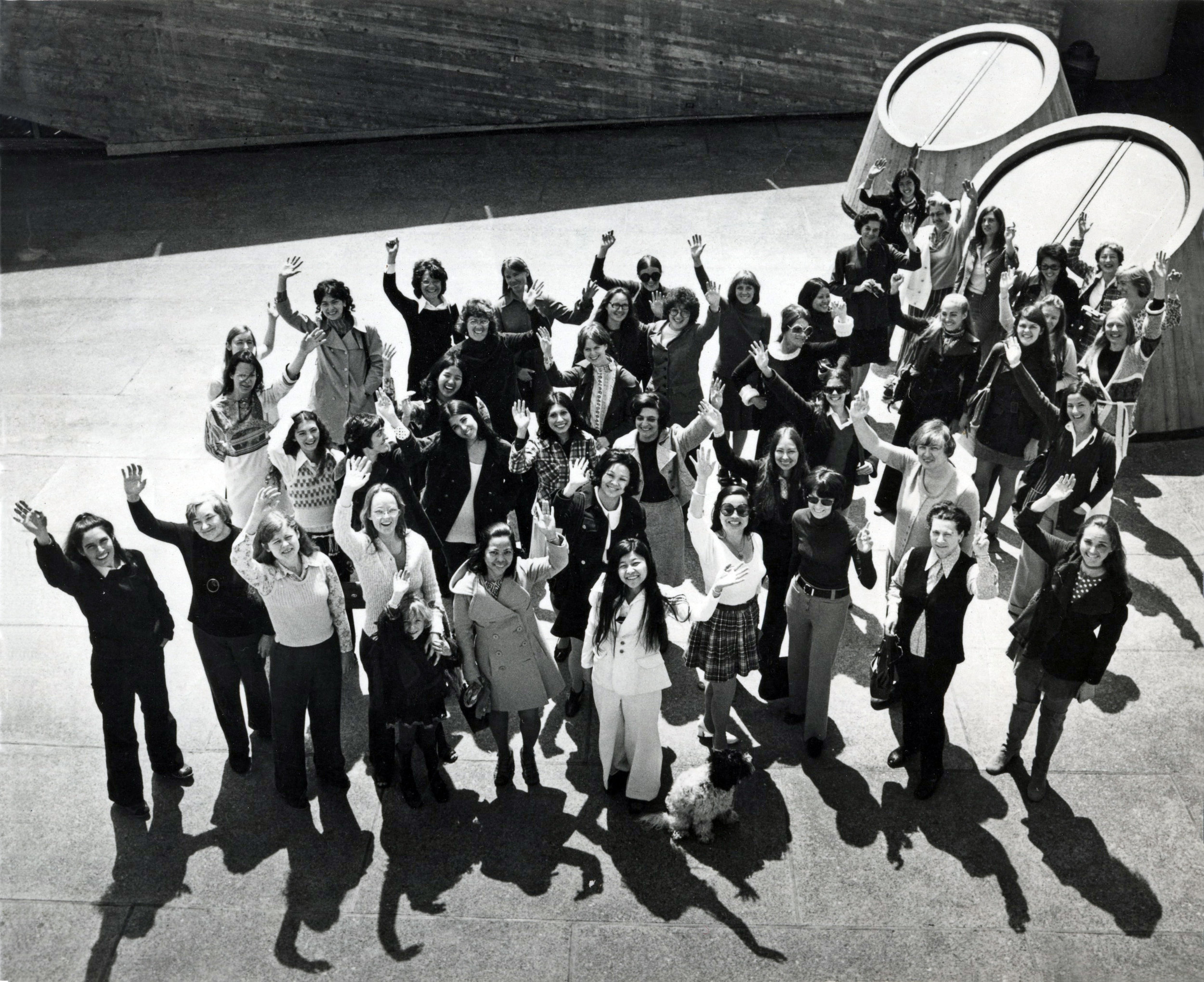As part of the women’s movement in architecture in the early 1970s, women began to form professional organizations. One of the first was Women in Architecture, Landscape Architecture, and Planning, organized by Dolores Hayden in Boston, MA. Hayden, then a graduate student at Harvard’s Graduate School of Design (GSD), invited local women in the environmental design professions to a meeting at her home on November 11, 1971. The group met almost weekly for the next month1 and then organized an open meeting at the Boston Architectural Center on March 4, 1972.2 By then the group had adopted its name. More than one hundred women attended, and Francine Achbar, a writer from a local paper, wrote about the meeting the following day.Achbar reported that “[the women’s] grievances were familiar. Many were the same complaints that have been raised by women in a variety of male-dominated professions in the past few years since the advent of the women’s liberation movement.”3
The organizers identified several areas that needed particular attention: the need for part-time work, legal action against discriminatory employers, professional education for women, and consciousness-raising groups. During its brief existence, WALAP tended to operate as an umbrella organization without a formal structure, providing contact among female practitioners in the Boston area and support for smaller, project-focused initiatives.
One of WALAP’s first projects was to support ongoing efforts to improve women’s status in the local schools of architecture, namely MIT’s Department of Architecture and Harvard’s GSD. Both schools were under internal and external pressure to increase the number of women students and faculty and to create hospitable environments for them. In 1971, the US Department of Health, Education, and Welfare (HEW) studied sex discrimination at both universities after the Women's Equity Action League and National Organization of Women jointly filed a complaint under Executive Orders 11246 and 11375.4 An architecture student at MIT, Tova M. Solo, sent a complaint to the Massachusetts Commission Against Discrimination about her experiences at MIT the following March. She felt the complaint had been overlooked in the HEW study.5 WALAP discussed these actions and the schools’ responses at their early meetings. MIT appears to have been more receptive to changing its policies and making efforts to recruit women. The head of the department, Professor Donlyn Lyndon, immediately asked a committee to investigate Solo’s complaint, and the department set a quota aiming for the next incoming class to be 33 percent women. At a meeting of the Education Council soon after Solo’s complaint, faculty members openly spoke about the need to address the departmental culture. Although they expressed that “raising the level of consciousness of these problems would be difficult,” they were willing to try.6
Harvard appears to have been less receptive to change. In a letter to the dean of the GSD, Maurice D. Kilbridge, Harvard president Derek C. Bok expressed the need to eliminate biases while resisting affirmative action targets he expected HEW to request.7 Kilbridge established the Committee on the Status of Women in late 1971. Around the same time, the GSD sent out a questionnaire to female graduates of the school. WALAP members, a couple of whom were on the GSD committee, were critical of both these efforts. Some of the more outspoken members of the committee, including WALAP member Megan Lawrence, felt Kilbridge’s intention was to create an “ineffectual committee” that could be blamed for the lack of progress in the school while demonstrating that the school was trying to make progress.8
WALAP members followed the proceedings of the Harvard committee through Lawrence and Bicci Pettit, another committee member and a founding member of WALAP. In a letter to Kilbridge in early 1972, WALAP members voiced their objections to the alumnae survey. Their reasons were: the implication “that the school has the option of continuing its present policies regarding the admissions and hiring of women”; that the questionnaire was only sent to women, therefore not providing a basis of comparison; that it focused on “women’s past role” rather than recognizing the changes to women’s roles; and the assumption made “that women must continue to adapt to the design and planning professions as they now exist.” The signatories felt that the professions needed to change for the benefit of women as well as “the fields as a whole.”9 As well as the letter to Kilbridge, WALAP members sent an open letter to the entire GSD in June of 1972. They wrote that women within the school were too few in number to have any power and were trying to apply outside pressure. They demanded that the school recruit more women students and faculty and give those women more positions on committees, including admissions and hiring.10
Another WALAP project was to address the problem of work schedules. The Board of Registration of Architects in Massachusetts did not recognize part-time work. A WALAP subcommittee wrote to the board in April 1972 objecting to the thirty-five hours a week required for work to count as full time.11 The subcommittee identified two groups with barriers to full-time work: mothers trying to balance careers with childcare and recent graduates unable to find full-time jobs in the economic climate of the time. WALAP requested that the Board remove the restrictions on part-time work.
The organization quickly expanded its interest from part-time schedules to questioning “the standard work schedule.” The result was “The Case for Flexible Work Schedules,” published in Architectural Forum.12 In it, the authors argued that for women to succeed in architecture, offices needed to change the culture that equated commitment with long work hours. Women were still the primary caregivers to children, and the authors thought that women needed flexibility to stay in the profession. They also believed that flexible schedules would help both female and male employees in reaching a better balance between their work and personal lives. Further, they argued that the projects would benefit from architects having more time for outside pursuits and thus a broader perspective. WALAP had disbanded by 1975, but it left an impact with the projects it took on in the education sphere and in combatting women architecture professionals’ isolation in the industry.
1 Meeting notes of women in environmental design group, November 11, 18, December 2, 9, 1971, held at Dolores Hayden’s home in Cambridge, MA, Ellen Perry Berkeley personal papers.
2 WALAP open meeting March 4, 1972, flyer, Berkeley personal papers.
Although there is no record of who attended the meetings in 1971, Ann Bernstein, Nancy Cynamon, Doris Cole, Zibby (Elizabeth) Ericson, Joan Goody, Shelly Hampden-Turner, Sally Harkness, Dolores Hayden, Margo Jones, Lisa Jorgenson, Olga Kahn, Isabel King, Megan Lawrence, Mary Gene Myer, Anne O’Rihilly, Bici Pettit, Vera Pratt, and Claudia Skylar were all listed as the organizers of the March 4th meeting.
3 Francine Achbar, “Women’s Group to Deal a ‘WALAP’ for Professional Equality,” Sunday Herald Traveler, Section 2, 24 (copy in Berkeley personal papers).
4 The WEAL/NOW complaint was aimed generally at universities for their discriminatory hiring policies, particularly the dearth of female faculty members. WALAP, “An Open Letter to Members of the Harvard Graduate School of Design,” June 15, 1972, copy in Berkeley personal papers.
5 Tova M. Solo, letter to the Massachusetts Commission Against Discrimination, March 20, 1972, copy in Berkeley personal papers.
6 MIT Department of Architecture Education Council minutes, April 25, 1972, Berkeley personal papers.
7 Derek C. Bok, letter to Maurice D. Kilbridge, December 27, 1971, copy in Berkeley personal papers.
8 Megan Lawrence, letter to Ellen Perry Berkeley, no date (c. May 1972), Berkeley personal papers.
9 WALAP, letter to Maurice D. Kilbridge, February 4, 1972, copy in Berkeley personal papers.
10 WALAP, “An Open Letter.”
11 Shelley Hampden-Turner, J. Lisa Jorgenson, and Jane Weinzapfel, on behalf of WALAP, letter to the Board of Registration of Architects, April 24, 1972, photocopy in Berkeley’s personal papers.
12 WALAP, “The Case for Flexible Work Schedules,” Architectural Forum 137 no. 2 (1972): 53, 66-67.











